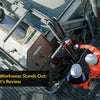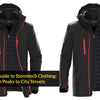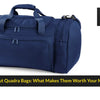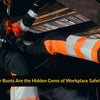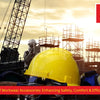Safety Footwear Guide
- by Cathy Houghton
Safety in the workplace is vital.
Playing a big part in keeping everyone safe on sites is wearing the right safety gear and footwear.
With safety footwear today, there's now a great deal of choice in style, type, and protection level.

No longer are we restricted to a bog-standard, uncomfortable, and heavy safety boot.
Today, we have a choice of brands, shoes, boots, trainers, and more!
Of course, this can also make it slightly more confusing and difficult when deciding on the most suitable footwear for you and your job role/function.
This is where Active Workwear comes in.
Below, we've provided a handy guide and some of our safety footwear tips, outlining the different safety footwear available so you can make sure you're fully informed and equipped.
Basics of safety footwear
Safety footwear forms part of personal protective equipment.
Their design focuses on preventing foot injuries and helping to prevent and limit trips and falls (due to their anti-slip soles).
However, finding the right safety footwear for you means all aspects of the job must be assessed, as all appropriate hazards should be tackled by other means in the first instance before PPE is handed out on demand.
When it comes to protecting your feet, you need to consider:
- Slip protection
- Toe protection
- Comfort, and
- Durability.
An industry where wearing safety boots is part of the norm is within construction. Construction workers require some form of safety footwear when working on sites and working outdoors. Typically boots in these instances must be waterproof, durable, include a solid sole, and have a toe cap feature.
However, within healthcare settings, shoes are typically required due to these items being lightweight, and comfortable, with slip protection features, and they’re washable.
Helly Hansen footwear has one of the most extensive ranges of safety footwear on the market. From boots to shoes and trainers, Helly Hansen is a brand that is renowned for its rigorous testing and durable, quality products.
The examples of different industry sectors we've mentioned above highlight the different features people may look for when searching for the right safety footwear.
Areas that ultimately need to be taken into consideration include:
- Potential for slips, trips, and falls
- Operating in areas of extreme temperatures
- Working in wet conditions
- Possibility of static electricity/shocks
- Chemical splash
- Increased possibility of punctures in the foot from sharp objects.
Safety footwear guide
Depending on the sector you work and the job role you carry out, as well as your own needs and wants, will depend on the type of safety footwear you choose.
The most common types available include:
Safety Boots – this is not just the most common but also the most popular. Safety boots are great if you also require a little extra protection around the ankle, as this type of safety footwear is durable, robust, and typically designed with heavy-duty materials, making them an excellent choice when working outdoors in the elements.
Helly Hansen footwear also incorporates additional safety features such as penetration resistant midsoles, slip-resistant soles, insulation against varying temperatures, and protective toe caps – great when operating heavy machinery or equipment.
Safety Shoes – smaller and more lightweight than the safety boot with composite options also available. Safety shoes are ideal for less hazardous situations, and within the Helly Hansen shoe range, some are also metal-free!
Safety Trainers – much more modern and aesthetically pleasing, these trainers are also comfortable and practical in equal measure. With some styles boasting reinforced toe caps and water-resistant elements, safety trainers can be a great option for long term jobs.
Slip-resistant shoes – the best feature about these shoes is their additional grip on the shoe's sole, which helps prevent slipping. Suitable for the catering and healthcare sector where spillages are more common. Or outdoors in wet and icy conditions.
Steel insole shoes – this shoe is perfect at offering its wearer underfoot protection. Helping to stabilise the foot, these shoes often come in smarter styles, so are ideal for executives when carrying out site visits.
Electric hazard shoes – antistatic footwear items like these, are specialist safety shoes designed to withstand electric shocks!
Clogs – a simple safety shoe, but a shoe that can also be fitted with steel toe caps, and their thin rubber soles providing a much quieter tread.
Wellington boots – great for wet and muddy conditions. Wellington boots keep your feet dry and protected. With safety and non-safety styles available, depending on your requirements, you also have the choice of style. Wellingtons are also a great choice when footwear needs to be washed and disinfected for hygiene reasons.
Riggers – the original pull-on safety boot. Riggers are a specialist type of safety boot renowned for providing the ultimate protection.
Safety footwear guidelines
The Health and Safety Executive imposes various guidelines and regulations relating to employee PPE, including appropriate footwear.
Regular risk assessments must be carried out, alongside processes, procedures, and the use of correct PPE to considerably reduce these risks.
Safety footwear should also meet all legal standards, be suitable for the job role, person, and environment.
The main guidance that safety footwear falls under includes Personal Protective Equipment at Work regulation 1992, and the Health and Safety at Work Act 1974.
Both regulations are there to protect employees and employers. The focus is on reducing all risk elements associated with different industries and work roles.
Controlling the risk with appropriate PPE and in this case, safety footwear is one of many measures that can be put in place.
To ensure that safety boots and shoes are up to standard, they will come with ratings, standards, and CE markings.
These elements allow the wearer to clearly identify exactly what a particular shoe feature includes, so hence what it protects against.
For example:
SB – Toe protection
A – Antistatic protection
E – Energy Absorption
WRU – Water-resistant upper
HRO – Heat resistant, and so on.
We'd advise checking all safety footwear descriptions and specifications, ensuring the correct code meets your requirements.
Final safety footwear tips
- Assess the risk
- Assess your working conditions and environment
- Is there a need for cut protection?
- Risk of falling objects.
- Ankle or heel support required?
- Risk of hazardous substances?
- Wet or damp conditions?
It's about wearing the correct footwear for the appropriate hazard/risk and checking they carry the right safety marks and identifiers.
At Active Workwear, we hold a wide range of different safety footwear types, and we have an extensive range of Helly Hansen footwear UK.

